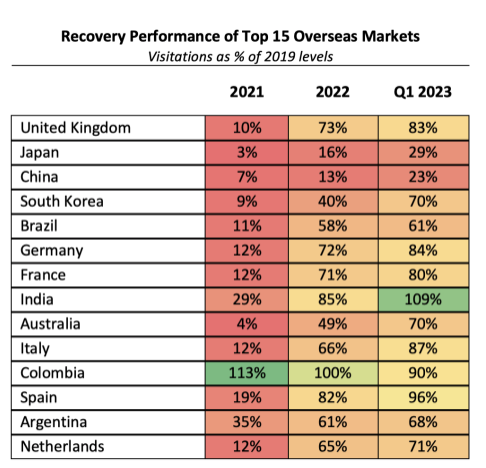International travel’s gradual return in an increasingly competitive global market

We are well into 2023, and the U.S. finally officially announced this week that it will be ending the COVID-19 vaccine requirements for international air travelers on May 11, the same day that the COVID-19 public health emergency ends.
This announcement is especially symbolic as the U.S. was the last major market to have such a restriction in place
We are well into 2023, and the U.S. finally officially announced this week that it will be ending the COVID-19 vaccine requirements for international air travelers on May 11, the same day that the COVID-19 public health emergency ends. This announcement is especially symbolic as the U.S. was the last major market to have such a restriction in place.
The latest: Inbound travel data for all overseas markets in Q1 2023 paints a mixed picture by country with some countries far behind, while others have performed remarkably well. However, the overall recovery of overseas travel is still lacking, with only a 70% rebound compared to pre-pandemic levels in 2019.
Dive deeper:
Among our top 15 overseas markets (ranked by 2019 visitations), the degree of recovery ranged from 109% (India) and 96% (Ireland and Spain) to just 23% (China) and 29% (Japan) in Q1 2023.
Nearly half of the top markets (7 out of 15) in Latin America & the Caribbean met or surpassed 2019 levels of visitations in Q1, but the region was just 79% recovered, due to still-slow progress from Brazil (just 61%).
ADVERTISEMENT
Travel from Canada has experienced a remarkable recovery and has surpassed 2019 levels so far this year, but travel from Mexico remains far behind.
Among European countries, visitations from Poland recovered to 140% of pre-pandemic levels in Q1. No other European (or nearly any) market came close. This can be attributed to Poland joining the Visa Waiver Program in November 2019. Poland ranked as our 36th largest overseas market in 2019 and the 25th largest in Q1 2023.
Travel’s surplus turned deficit: While inbound travel has struggled to recover, outbound travel from the U.S. has performed remarkably well. As a result, so far this year, travel imports (money spent by Americans abroad) have exceeded travel exports (money spent by foreigners in the U.S.). In other words, travel has produced a trade deficit. This means that travel has lost its ability to reduce our overall trade deficit as it has for many decades.
In fact, prior to July 2021 the U.S. has never recorded a monthly travel trade deficit; since then, however, the U.S. has run a travel trade deficit for ten of the last twenty months (50% of the time).
Remaining competitive: As many countries around the world are taking advantage of international travel’s comeback to refresh their own strategies—whether in terms of marketing, improving the travel experience or actively engaging with other markets to facilitate bilateral tourism—the global travel market has become increasingly competitive.
For example:
Saudi Arabia has a concrete plan to become a global hub, launching a new global airline, and aims to attract 100 million visitors by 2030.
Many European countries such as Spain and the United Kingdom have concrete plans for an end to the liquid ban on carry-on luggage, thanks to advanced technology. And some airports such as London City have already lifted this restriction.
China has been actively forging tourism-related cooperation with new markets including Tanzania, Russia, and most recently, Iran to which Chinese citizens no longer need visas.
The United Kingdom, just this past November, removed visa requirements for citizens of Colombia, Peru and Guyana.
The U.S. needs to take an increasingly active role in learning from various best-practices among our competitors and continuously work to keep improving the travel experience at every step of the process.


